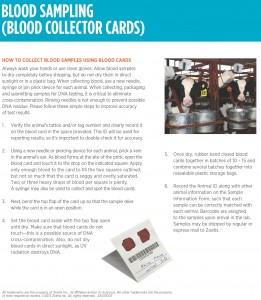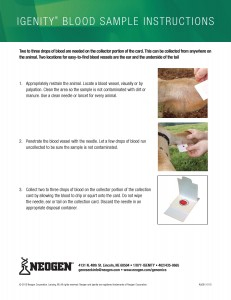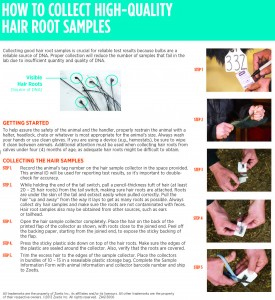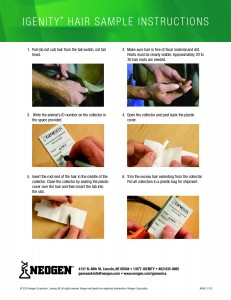All DNA submissions must have either a registration number or performance number in order for them to be processed and sent to the lab.
For questions email BBUDNA@beefmasters.org.
NEOGEN IS BEEFMASTER’S PREFERRED DNA VENDOR
Use the forms below to collect and submit your DNA to NEOGEN
DNA Frequently Asked Questions
- What is the difference between STRs and SNPs?
- STRs - The proper name for STR is Short Tandem Repeat analysis. This is the old type of marker analysis that was used previously before the industry transitioned to the new SNP analysis in 2012. When a sample is tested with STR analysis there are 11-14 NUMBER markers that the lab looks at and can compare with another animal’s markers to determine parent verification. As the labs have now moved to SNP analysis, STR analysis is no longer used except on a case-by-case basis.
- SNPs - The proper name for SNP is Single-nucleotide Polymorphism (often referred to as snip). This is the new type of marker analysis that is currently used in today’s genetic market. Every sample submitted to either Zoetis or NEOGEN for a Genotype panel or Parentage Analysis is run on SNPs. Contrary to the STR analysis, when a sample is tested with SNPs there are 80-110 LETTER markers that the lab looks at and can compare with another animal’s markers to determine parent verification.
- My sire/dam was DNA typed back a few years ago on STRs. Why can I not compare back to that now, or why is there an additional charge to do so?
- When a sample is submitted for genotyping or parent verification it is run on a SNP analysis. If the sire or dam of this animal was DNA typed back several years ago and only has STRs on file they cannot be compared to the SNPs as this is two different types of markers (explained above). If possible, it is in your best interest to either submit a new sample for that parent so it can be run on SNPs, or if the sample on file is viable for additional testing to have that sample pulled and run on SNPs. If that sire or dam is no longer alive to have an additional sample submitted for SNPs and the sample on file is not viable for additional testing, then that parent cannot be compared back to the calf using SNPs. As a last resort, the calf can be run on STRs to be able to compare back to the parent but there is an additional cost for this testing and approval from BBU staff is required.
- If either the parent has to be run on a SNP test to compare to the calf or the calf run on an STR test to compare back to the parent there is an additional fee, as the lab now has to run a completely different test. The fee is $15.00 for an additional STR or SNP test.
- What is the difference between the HD and LD genotype?
- The High Density (HD) Genotype is a panel of 50,000-150,000 SNP markers. When your animal is run on an HD Genotype it will receive Genomic-Enhanced EPDs (GE-EPDs) and parent verification if the parents have DNA on file. To qualify, all A.I. sires and embryo donor dams are required to be run on the HD Genotype and must be parent verified back to both sire and dam.
- The Low Density (LD) Genotype is a panel of 50,000 SNP markers. This testing is currently only offered through NeoGen NEOGEN. When your animal is run on an LD Genotype it will also receive GE-EPDs and parent verification if the parents have DNA on file.
- The Ultra-Low Density (uLD) Genotype is a panel of 30,000 SNP markers at NEOGEN. When your animal is run on the uLD panel it will receive parent verification as well as GE-EPDs.
- What exactly do I get when my animal is genotyped?
- The first and most important thing that your animal will receive when genotyped on the HD or LD panel is GE-EPDs. GE-EPDs have increased accuracy over the general EPDs and ONLY animals that have been genotyped will receive these enhanced EPDs. Parentage Analysis is also included when having your animal genotyped, as long as the parents have DNA on file. There is no additional charge for parent verification when your animal is genotyped unless there is an issue with STR vs. SNP comparison, as discussed above. Only then would there be an additional charge to have that animal parent verified.
- Unlike when having an animal parent verified, there is no official report that you will receive when an animal is HD genotyped. Again, you will see the results of this test when the GE-EPDs are available. BBU will send you a confirmation report that simply states that your animals have successfully been genotyped and the information has been recorded with our geneticist.
- What does it mean when my animal comes back as DNA disputed?
- When you receive a DNA report that states that your animal is DNA disputed this means that the animal either did not qualify to the dam, to the sire or to both parents. When comparing SNP markers only 1-2 DNA exclusions is allowed and if there are any more than this the animal is considered excluded to that parent. This means that the sire or dam provided is not the correct parent of the calf.
- What is the process to resolve a DNA dispute?
- After receiving a DNA report that shows a DNA dispute the first step is to contact BBU. You will need to inform us of an alternate sire or dam to have the lab test against. If that parent has DNA on file to compare back to, the lab can run a re-look on your animal. If it does qualify back to that parent your next step would be to then return the certificate for the animal to have it corrected in the system. If that parent does not have DNA on file but you believe it is the only other possible option we can make the correction per the breeder’s authorization but cannot record the animal as parent verified as the parent does not have DNA on file to compare back to. In this case, you would still need to return the original certificate of that animal to have the parentage corrected.
- What if I have several different sire options that my calf could be out of? How do I apply for the DNA?
- If you have multiple sires that your calf could possibly be out of, DNA is the best way to accurately decipher which sire is the correct sire. You can submit a DNA sample for the calf and have it tested to the multiple sire options to see which sire qualifies.
- When submitting the DNA sample for the calf, on the submission paperwork you would list ALL possible sire options the calf could be out of. When the sample is submitted to the lab they will test the calf against each option, as long as that sire has DNA on file, and can tell you which sire is correct.
- My animal qualified to both the sire and dam on an individual basis but it is excluded at the mating pair (trio)? Why is this? How can this occur? How can I resolve the issue?
- This can happen in rare cases where the calf will qualify to the sire on an individual basis and the dam on the individual basis but will exclude at the mating pair. This means when the sire and dam were compared TOGETHER against the calf there were exclusion markers present. As this is a rare occurrence, it is handled on a case-by-case basis. Normally this happens because the actual sire or dam is closely related to the sire or dam that the calf was tested against. It could be a full sibling, half sibling, etc.
- The first step is that an alternate sire or dam option should be given to test against to see if we can get it to qualify. If the dispute is still not cleared up after trying several other options, it would be recommended that a new sample be submitted for the calf and possibly the sire and dam, if necessary.
- How do I get sample cards to submit for DNA testing?
- To request DNA sample cards or TSUs you can contact BBU at (210) 732-3132 or you can email bbudna@beefmasters.org. When requesting sample cards or TSUs we need to know which lab you are currently using, Zoetis or NEOGEN, how many cards or TSUs you would like, and if you would like blood cards or hair cards. When the sample cards are mailed out we also include the DNA Submission Paperwork. This is what needs to filled out, signed and submitted with the DNA cards after the sample has been collected.
How to Collect DNA Samples
Collecting a DNA sample is easy, but collecting a good DNA sample is crucial to receiving prompt and accurate results. As a Beefmaster breeder it is required that DNA samples be collected and processed through Zoetis or NEOGEN on all embryo and semen donor dams and sires. The process of collecting quality DNA blood, hair or tissue samples is important to understand for all Beefmaster breeders. If a bad DNA sample is provided then the DNA-testing lab cannot efficiently extract the DNA. If you currently, or plan to in the future, collect DNA samples please become familiar with the instructions below. If you are more of a "see-then-do" learner, please view the Hair Sample How to Video or the Blood Sample How to Video.
If you need to order a DNA hair or blood kit, please contact the office at 210-732-3132 or bbudna@beefmasters.org.
How to Collect Blood Samples using Blood Cards
Always wash your hands or use clean gloves. Allow blood samples to dry completely before shipping, but do not dry them in direct sunlight or in a plastic bag. When collecting blood, use a new needle, syringe or pin prick device for each animal. When collecting, packaging and submitting samples for DNA testing, it is critical to eliminate cross-contamination. Rinsing needles is not enough to prevent possible DNA residue. Please follow these simple steps to improve accuracy of test results:
- Verify the animal's tattoo and/or tag number and clearly record it on the blood card in the space provided. This ID will be used for reporting results, so it's important to double-check it for accuracy.
- Using a new needle or piercing device for each animal, prick a vein in the animal's ear. As blood forms at the site of the prick, open the blood card and touch it to the drop on the indicated square. Apply only enough blood to the card to fill the two squares outlined, but not so much that the card is soggy and overly saturated. Two or three heavy drops of blood per square is plenty. A syringe may also be used to collect and spot the blood cards.
- Next, bend the top flap of the card up so that the sample dries while the card is in an open position.
- Set the blood card aside with the top flap open until dry. Make sure that blood cards do not touch'this is a possible source of DNA cross-contamination. Also, do not dry blood cards in direct sunlight, as UV radiation destroys DNA.
- Once dry, rubber band closed blood cards together in batches of 10 ' 15 and combine several batches together into resealable plastic storage bags.
- Record the Animal ID along with other animal information on the Zoetis Sample Information Form or the NEOGEN DNA Submission Form, such that each sample can be correctly matched with each animal. Barcodes are assigned to the samples upon arrival in the lab.
7. Send DNA sample to Beefmaster Breeders United, 118 W. Bandera Road, Boerne, TX 78006.


How to Collect High-Quality Hair Root Samples
Collecting good hair root samples is crucial for reliable test results because bulbs are a reliable source of DNA. Proper collection will reduce the number of samples that fail in the lab due to insufficient quantity and quality of DNA.
Getting Started
To help assure the safety of the animal and the handler, properly restrain the animal with a halter, headlock, chute or whatever is most appropriate for the animal's size. Always wash your hands or use clean gloves. If you are using a device (e.g., hemostats), be sure to wipe it clean between animals. Additional attention must be used when collecting hair roots from calves under four (4) months of age, as adequate hair roots might be difficult to obtain.
Collecting The Hair Samples
Steps:
- Record the animal's tag number on the hair sample collector in the space provided. This animal ID will be used for reporting test results, so it's important to doublecheck for accuracy.
- While holding the end of the tail switch, pull a pencil-thickness tuft of hair (at least 20 ' 25 hair roots) from the tail switch, making sure hair roots are attached. Roots are under the skin of the tail and extract easily when pulled correctly. Pull the hair 'up and away' from the way it lays to get as many roots as possible. Always collect dry hair samples and make sure the roots are not contaminated with feces. Hair root samples also may be obtained from other sources, such as ears or tailhead.
- Open the hair sample collector completely. Place the hair on the back of the printed flap of the collector as shown, with roots close to the joined end. Peel off the backing paper, starting from the joined end, to expose the sticky backing of the flap.
- Press the sticky plastic side down on top of the hair roots. Make sure the edges of the plastic are sealed around the collector. Also, verify that the roots are covered.
- Trim the excess hair to the edges of the sample collector. Place the collectors in bundles of 10 ' 15 in a resealable plastic storage bag.
- Record the Animal ID along with other animal information on the Zoetis Sample Information Form or the NEOGEN DNA Submission Form, such that each sample can be correctly matched with each animal. Barcodes are assigned to the samples upon arrival in the lab.
- Send DNA sample to Beefmaster Breeders United, 118 W. Bandera Road, Boerne, TX 78006.


How to Collect Tissue Samples
1. Remove a TSU punch from the packaging. Punches should be assembled as one piece; if they have come apart, reassemble. Open the tube retainer at the base of the applicator by pushing the retainer clip.
2. Insert the punch into the applicator. Release the clip to lock punch into the device. Carefully squeeze the applicator handles together, guiding the punch tip into place if necessary. When the gun bolt rests flush against the red plastic clip, release the handle.
3. Remove the red plastic clip by pulling it outward. Be careful as the metal cutter above the clip is very sharp. Ensure the applicator is loaded with an unused punch (if the red plunger is visible, the punch is used and should be replaced with one that is unused).
4. Slide the applicator over the animal’s ear and position the metal cutter one inch from the edge of the ear, making sure to avoid any obvious veins or ridges. Squeeze handles together to take a sample and then release to free the ear. Try to do this in one swift, fluid motion.
5. Remove the punch from the applicator and check that sampling has been successful. If not, discard the sample and proceed with a new punch. Remove the used cutter from the applicator by pulling the handles apart. Discard carefully as the cutter is very sharp.
6. Record the Animal ID along with other animal information on the Zoetis Sample Information Form or the NEOGEN DNA Submission Form, such that each sample can be correctly matched with each animal. Barcodes are assigned to the samples upon arrival in the lab.
7. Send DNA sample to Beefmaster Breeders United, 118 W. Bandera Road, Boerne, TX 78006.
Hair cards for NEOGEN will now be $6.00 ($2.00/hair card + $4.00/processing fee). This is an additional fee to the actual DNA test, not included. Along with blood and hair samples, we also accept tissue samples. We do have the Allflex Tissue Sampling Unit (TSUs) available in the office for purchase. The Allflex tissue applicator is $50.00. The Allflex tissue punches are $25/per box and there are 10 punches in each box.
Zoetis DNA Submission Form (Requires Microsoft Excel To Open)